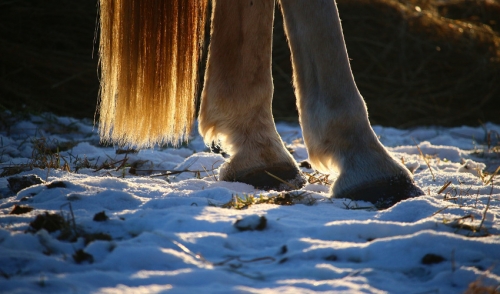
Preventing Snowballs in Your Horse’s Hooves
When it comes to preventing snowballs in your horses’ hooves, many of our clients find that home-grown solutions are easiest and relatively effective. If your horse is only in the snow from time to time, products you most likely already have at home are adequate means of preventing snowballs. If this is the case, we find that spraying a vegetable-oil-based solution (half water, half oil) will do the trick. Other clients have found that Pam® Cooking Spray serves the same function. If you are not afraid of a little goopy mess, try coating your horse’s hooves in Vaseline or the like.
On a related tangent, many of our clients are most concerned about snowballs due to their tendency to form ice packs in the inner parts of the hoof. To address this problem, we have found a relatively easy answer that will relieve much of your anxiety and frustrations in winter. You should not have to chip away at ice packs; instead, merely tap the front of the hoof with a small hammer or the end of a hoofpick. The chunk of ice should fall away easily.
Another alternative, particularly if your horse will be outdoors often, or in areas with heavy snowfall, is some type of snowball pad. Among snowball pads you will, generally speaking, find three types from which choose. The first is a flat pad made of plastic—these work best when coupled with some extra cooking spray or grease, as mentioned above. The second type features a bubble in the middle of the pad (which should point down as you apply it to the hoof). The final pad most prevalent on the market is an inner rim pad, which, when put on, will sit higher than the ground surface of the shoe. This rim pad is designed in such away that the rim will compress on impact and dislodge the snow.
If you opt for a snowball pad that covers the entirety of the hoof, you will need to be alert to debris, moisture and bacteria that may become trapped beneath the pad. With these products, it is best to consult your farrier, who will probably apply the pad with silicon or another sealant (some of which are specifically medicated to prevent microbial growth).
So, the next time you throw on your boots to head out to the stables, think twice about whether or not your horse might need a little fancy footwear for the snow as well. If he/she is only spending a short time out to pasture, or going on a quick trail ride, we recommend taking the easier route and simply applying a homemade solution. However, if your winters are months long at home and your horse will be spending lots of time dashing through the snow (one-horse open sleigh, optional), think about investing in a more permanent snowball pad!
